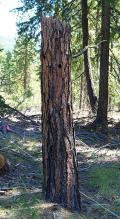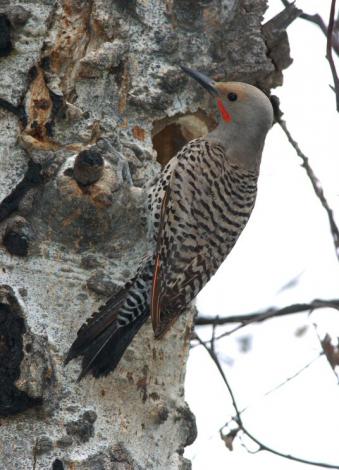Interior ponderosa pine (Pinus ponderosa) forests of the Pacific Northwest have changed dramatically since the time of European settlement. As a result of decades of fire suppression and timber management that focused on selective removal of large-diameter trees, ponderosa pine forests today have high densities of small diameter trees and low densities of large diameter trees and snags, as well as an encroachment of shade tolerant tree species. In response, some land management agencies and private industrial landowners use forest management practices (for example, thinning harvests and controlled understory burns) to reduce fire intensity and aid in restoring ponderosa pine forests to a condition that is open, park-like, and dominated by large-diameter trees. However, it will take many years and multiple management actions to reach this goal. Therefore, it is important to understand how cavity-nesting birds use current forest conditions, particularly in regard to nest-site characteristics, because land managers can manipulate these habitat features.
The White-headed Woodpecker (Dryobates albolarvatus) inhabits interior pine forests from British Columbia, Canada, to southern California. The Hairy Woodpecker (D. villosus) and Northern Flicker (Colaptes auratus) are primary cavity excavators that occur in a wide variety of forest types in North America. These three species occur within ponderosa pine forests of Washington. It is therefore important, especially in the context of managing lands for timber production and dry-site forest restoration, to determine the extent that nest-site characteristics differ between these three woodpecker species. If nest-site characteristics differ considerably, managers may have to manage a suite of features appropriate for each of the species, where as if nest-site characteristics are similar, managers could manage for one or two important habitat features required by all three species.
My goal was to evaluate how the White-headed Woodpecker, Hairy Woodpecker, and Northern Flicker use managed ponderosa pine forests for breeding in Washington. My objectives for this study were to: 1) describe the characteristics of nest trees or snags and other fine-scale habitat features associated with nest sites of the three woodpecker species in burned and unburned treatments; and 2) evaluate differences in nest-site characteristics among these species within each treatment.
Describe and compare the nest site characteristics of three woodpecker species that occur within managed ponderosa pine forests of the eastern Cascade Range of Washington. Managed ponderosa pine forests include those that are unburned but that have a history of forest management and those that are burned and where salvage logging has occurred. This project was conducted primarily within Yakima County on land owned by the USFS, Washington DNR, private industrial landowners, and small private landowners.
This project was completed in 2010 and the results published in the peer-reviewed journal The Northwestern Naturalist in 2012. The .pdf of this paper and those of related papers can be accessed by clicking the links below.
Status: Completed
04/01/2003 to 09/01/2010Project Manager
-
Jeff Kozma ,
Timber, Fish and Wildlife (TFW), Wildlife Biologist
509-865-5121 x6343




